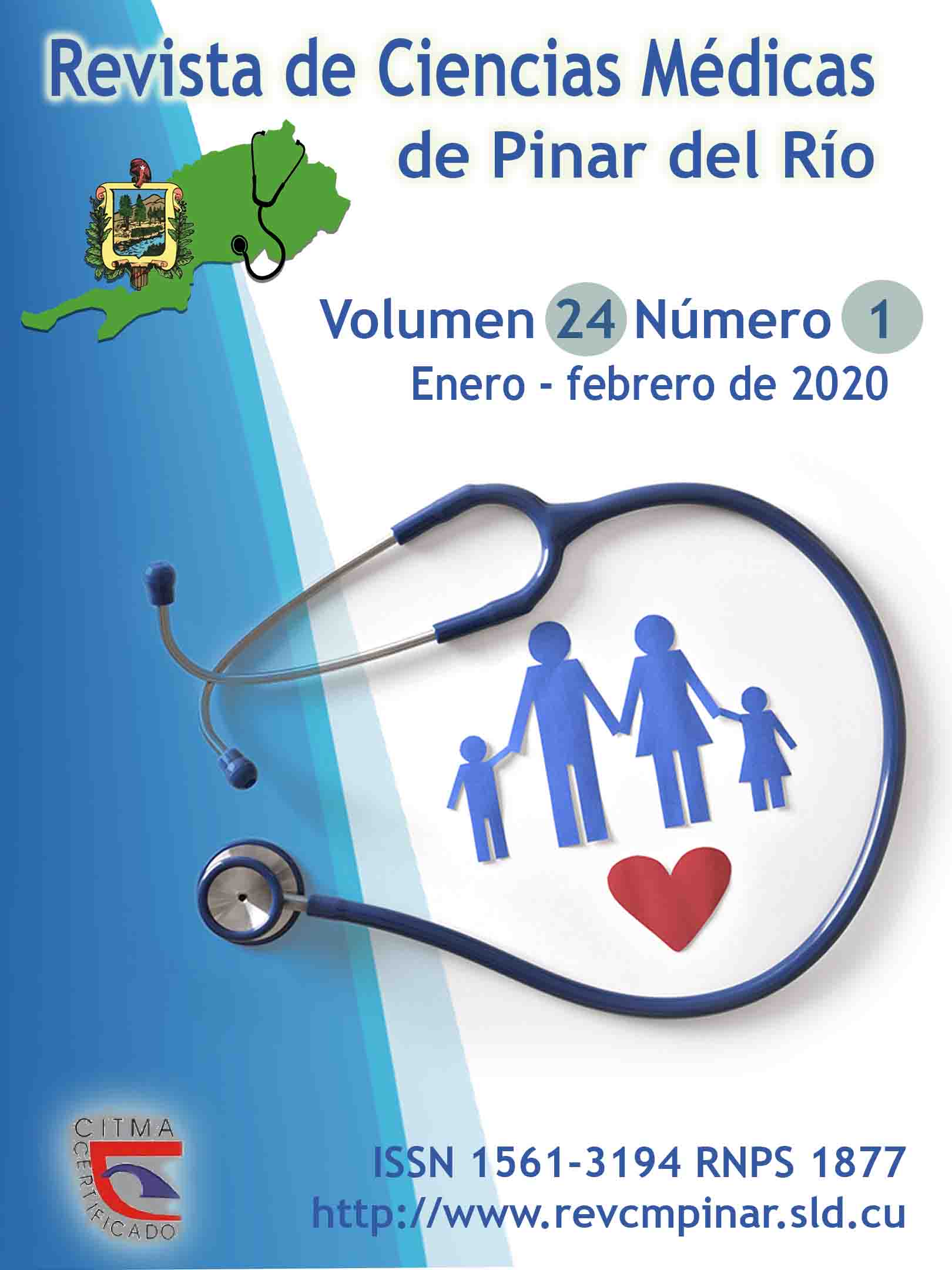Most frequent dermatoses in the elderly of Pinar del Río
Keywords:
SKIN DISEASES, SKIN, SKIN PHYSIOLOGICAL PHENOMENA, SKIN AGING, SKIN CARE, AGED, HEALTH OF THE ELDERLY, DERMATOLOGY.Abstract
Introduction: population aging currently causes an increase in conditions related to skin integrity disorder, with dermatoses being frequent diseases in the manager.
Objective: to describe the behavior of dermatoses in older adults.
Methods: an observational, descriptive cross-sectional study, carried out in the municipality of Pinar del Río during 2018. A sample of 1164 geriatric patients with dermatological conditions was selected in a probabilistic way, using random medical records and dermatological examination for the Obtaining information that output the variables studied. Medical ethics was respected.
Results: predominantly females (51,98 %) and age group 60-64 years (34,19 %), skin phototype III (23,11 %) being the most frequent demonstrated by dermatological conditions. Among them, ectoparasitosis (16,15 %) and cutaneous virosis (14,95 %) were the most representative, showing greater representation in individuals with white skin color, an exception to ectoparasitosis. Within the associated pathologies, diabetes mellitus was the most frequent.
Conclusions: the timely identification of the presence of dermatosis in AM, and especially in those that meet risk factors linked to its appearance, acting early in the management of various conditions, reducing the occurrence of complications and sequelae affected by themselves; while improving the quality of life of said patient.
Downloads
References
1. Creagh Peña M, García Ones D, Valdés Cruz R. Envejecimiento poblacional como reto de la ciencia, la técnica y la sociedad. Rev haban cienc méd [Internet]. 2015 [citado 04/03/2019]; 14(6): 884-886. Disponible en: http://scielo.sld.cu/scielo.php?script=sci_arttext&pid=S1729-519X2015000600017&lng=pt
2. Linares Cánovas LP. Enfermedades crónicas no transmisibles en el adulto mayor. Univ Méd Pinareña [Internet]. 2018 [citado 04/03/2019]; 14(3): 195-196. Disponible en: http://galeno.pri.sld.cu/index.php/galeno/article/view/547
3. Naranjo Hernández Y, Figueroa Linares M, Cañizares Marín R. Envejecimiento poblacional en Cuba. Gac Méd Espirit [Internet]. 2015 [citado 04/03/2019]; 17(3): 223-233. Disponible en: http://scielo.sld.cu/scielo.php?script=sci_arttext&pid=S1608-89212015000300025&lng=pt
4. Fernández Martell RM, Dopico Toledo AP, Fernández Cárdenas EJ, Rodríguez Carracelas J, Sánchez Fernández CM, Rojas Lamadrid B. Comportamiento de las afecciones cutáneas en el adulto mayor. Policlínico Docente Héroes del Moncada. Municipio Cárdenas. Matanzas. Rev Méd Electrón [Internet]. 2018 [citado 04/03/2019]; 40(6). Disponible en: http://www.revmedicaelectronica.sld.cu/index.php/rme/article/view/2453/4097
5. Vargas-Alvarado A, Salinas-Martínez R, Ocampo-Candiani J. Epidemiología de la dermatosis en pacientes geriátricos. Rev Med Inst Mex Seguro Soc [Internet]. 2009 [citado 04/03/2019]; 47 (3): 285-289. Disponible en: https://www.medigraphic.com/pdfs/imss/im-2009/im093i.pdf
6. Cheirif-Wolosky O, Vélez-Muñiz RC, Tinoco-Fragoso F, Hernández-Salcedo D, García-Hidalgo L. Dermatosis frecuentes en pacientes geriátricos hospitalizados en un servicio de medicina interna. Dermatol Rev Mex [Internet]. 2017 [citado 04/03/2019]; 61(6): 441-448. Disponible en: https://www.medigraphic.com/pdfs/derrevmex/rmd-2017/rmd176b.pdf
7. Pérez-Ros P, Martínez-Arnau FM, Sabater-Ramirez J, Tarazona-Santabalbina FJ. Calidad de vida dermatológica en ancianos frágiles comunitarios. Aten Primaria [Internet]. 2016 [citado 04/03/2019]; 48(10): 683-684. Disponible en: https://www.elsevier.es/es-revista-atencion-primaria-27-pdf-S0212656716300944
8. Reszke R, Pełka D, Walasek A, Machaj Z, Reich A. Skin disorders in elderly subjects. International Journal of Dermatology [Internet]. 2015 [citado 04/03/2019]; 54(9): 332-338. Disponible en: https://onlinelibrary.wiley.com/doi/abs/10.1111/ijd.12832
9. Fajardo Ramos E. Lesiones de piel en adulto mayor. Revista Edu-Física [Internet]. 2016 [citado 04/03/2019]; 8(18): 23-32. Disponible en: http://revistas.ut.edu.co/index.php/edufisica/article/view/1001/864
10. Goyal A, Balai M, Mittal A, Khare AK, Gupta LK. Pattern of geriatric dermatoses at a Tertiary Care Teaching Hospital of South Rajasthan, India. Our Dermatology Online [Internet]. 2017 [citado 04/03/2019]; 8(3): 237-241. Disponible en: https://pdfs.semanticscholar.org/d2ad/d422bbb1a7fd349cfa3e90d595ec91f7d9e4.pdf
11. Sheethal MP, Shashikumar BM. A cross-sectional study on the dermatological conditions among the elderly population in Mandya city. International Journal of Medical Science and Public Health [Internet]. 2015 [citado 04/03/2019]; 4(4): 467-470. Disponible en: 10.5455/ijmsph.2015.2711201497
12. Martínez García G, Guerra Castro MM. Dermatosis frecuentes en pacientes geriátricos de la ciudad de Matanzas. Rev Méd Electrón [Internet]. 2012 [citado 04/03/2019]; 34(3): 309-320. Disponible en: https://www.medigraphic.com/pdfs/revmedele/me-2012/me123f.pdf
13. Raveendra L. A clinical study of geriatric dermatoses. Our Dermatol Online [Internet]. 2014 [citado 04/03/2019]; 5(3): 235-239. Disponible en: http://www.academia.edu/download/34344214/1.geriatric-RaveendraL.pdf
14. Jindal R, Jain A, Roy S, Rawat SD, Bhardwaj N. Skin disorders among geriatric population at a Tertiary Care Center in Uttarakhand. Journal of clinical and diagnostic research [Internet]. 2016 [citado 04/03/2019]; 10(3): 6-8. Disponible en: https://www.ncbi.nlm.nih.gov/pubmed/27134982
Downloads
Published
How to Cite
Issue
Section
License
Authors who have publications with this journal agree to the following terms: Authors will retain their copyrights and grant the journal the right of first publication of their work, which will be publication of their work, which will be simultaneously subject to the Creative Commons Attribution License (CC-BY-NC 4.0) that allows third parties to share the work as long as its author and first publication in this journal are indicated.
Authors may adopt other non-exclusive license agreements for distribution of the published version of the work (e.g.: deposit it in an institutional telematic archive or publish it in a volume). Likewise, and according to the recommendations of the Medical Sciences Editorial (ECIMED), authors must declare in each article their contribution according to the CRediT taxonomy (contributor roles). This taxonomy includes 14 roles, which can be used to represent the tasks typically performed by contributors in scientific academic production. It should be consulted in monograph) whenever initial publication in this journal is indicated. Authors are allowed and encouraged to disseminate their work through the Internet (e.g., in institutional telematic archives or on their web page) before and during the submission process, which may produce interesting exchanges and increase citations of the published work. (See The effect of open access). https://casrai.org/credit/



